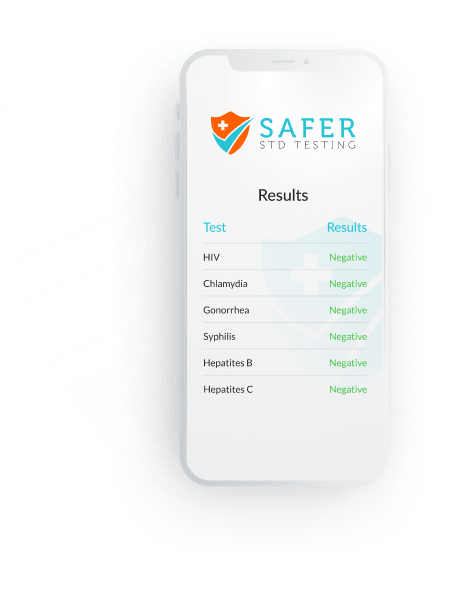

If not treated, syphilis can cause a variety of health problems, progressing through four stages:2

Anybody with signs or symptoms of syphilis should be tested.
Screening means getting tested for a disease before it starts to cause symptoms
or serious health problems. The Centers for Disease Control and Prevention recommend that the following people should be screened for syphilis:2
Because of the devastating effects of congenital syphilis, all pregnant women should be screened for syphilis.2 Screening is recommended at the first prenatal visit, with repeat screening in the third trimester and at delivery for women who are at high risk for syphilis. In addition, all infants born to women with syphilis should be tested for congenital syphilis.
Syphilis may cause a wide variety of symptoms.2 The disease is often referred to as the “Great Pretender” because it can appear like many other conditions.
On average, it takes 3 weeks for symptoms to appear after getting infected with syphilis, but the time frame varies widely. Sores (chancres) appear where the infection first entered the body, such as on or near the genitals, rectum, or mouth. The sores are usually round, firm, and painless. The chancres last for about 3 to 6 weeks.
If the infection is not treated in the primary stage, it progresses to the secondary stage — even if the chancres have disappeared on their own. Symptoms of the secondary stage include the following:
If secondary syphilis is not treated, the infection will enter the latent, or hidden, stage. This is a long period when the infection persists in the body but causes no symptoms. Treatment of latent syphilis depends on whether the infection started in the past year (early latent) or more than a year ago (late latent).
Syphilis affecting parts of the nervous system.2,3 It can appear during any stage of the infection. There are 5 types of neurosyphilis:
Syphilis affecting the eyes and vision. Like neurosyphilis, it can happen at any stage.2
Appears about 10 to 30 years after the initial infection.2 Manifestations of this severe infection include:
When a woman with syphilis passes the infection on to her baby during pregnancy.2,5
The sores caused by syphilis also makes it easier to get and spread HIV.
Syphilis is usually diagnosed with a series of blood tests.2,6
like VDRL and RPR are used to screen for syphilis because they’re simple and quick to perform. A negative result during initial screening means that the test did not detect syphilis. A positive result could be caused by syphilis or other conditions and thus needs to be confirmed with a treponemal test.
like FTA-ABS, TP-PA, and other tests are designed to detect antibodies that your body makes in response to syphilis infection.
In the traditional approach to testing syphilis, a positive nontreponemal blood test followed by a positive treponemal blood test means you have current or past syphilis infection. This is the more common way to diagnose syphilis.
In the reverse testing algorithm, a positive treponemal test followed by a positive nontreponemal test means you have current or past syphilis infection.
Keep in mind it’s possible to have syphilis and have negative test results if the exposure to the infection was recent.
Testing for neurosyphilis involves a spinal tap and examining the spinal fluid for signs of the infection.
Anybody who is diagnosed with syphilis should also be tested for HIV. The sores caused by syphilis increase the risk of getting and spreading HIV.
Before starting treatment for syphilis, your health care provider may ask about the
following:
Syphilis is treated with penicillin. The form, dose, and way of administering penicillin must be properly matched to the stage of syphilis. Oral penicillin tablets are not effective for syphilis. The following are recommended treatment regimens for adults:7
is treated with a single dose of 2.4 million units of benzathine penicillin G injected in the muscle.
is treated with 2.4 million units of benzathine penicillin G injected in the muscle every week for 3 weeks (7.2 million units total).
is treated with 18 to 24 million units of aqueous crystalline penicillin G given intravenously every day for 10 to 14 days.
It is recommended to monitor symptoms and lab tests after treatment to confirm elimination of the infection.
If a nonpregnant person with syphilis is allergic to penicillin, treatment options include doxycycline or tetracycline.
with syphilis should be treated with the penicillin regimen matched to her stage of infection. If a pregnant woman with syphilis is allergic to penicillin, she should undergo a penicillin desensitization process in order to allow safe treatment with penicillin.8
of people with primary, secondary, or early latent syphilis may need to be treated for syphilis.
The only certain way to avoid getting syphilis is to avoid vaginal, anal, or oral sex.
If you are sexually active, consider these measures to lower your risk of getting or
transmitting syphilis:
Treatment for syphilis can cure the infection but it does not protect you from getting it again. Reinfection with syphilis is common. It’s important to get retested for syphilis if you’ve had a new exposure after treatment.
The best way to prevent congenital syphilis in a baby is to prevent and treat syphilis in pregnant women and their sexual partners.
There is no vaccine available to prevent getting syphilis.
Researchers are developing and testing syphilis vaccines.
Question: When is syphilis contagious?
Answer: Syphilis can be spread during sex when there are sores on the skin or mucous membranes of the mouth, rectum, and genitals. Primary, secondary, and early latent syphilis are




